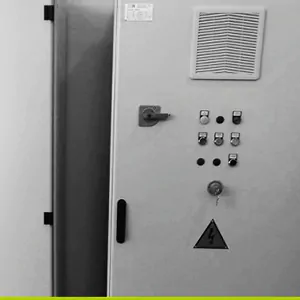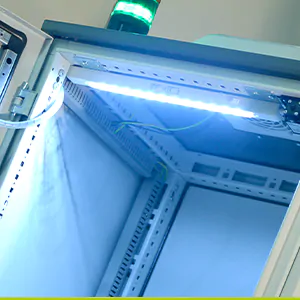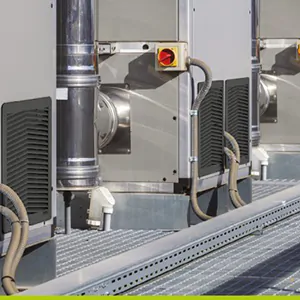10 Key Factors for Enclosure Cooling
We discuss some of the key things to consider in enclosure cooling.
The thermal conditions in enclosures and cabinets directly impact the longevity of the electrical and electronic components they house. Therefore, it is necessary to avoid certain pitfalls when cooling the enclosure that could lead to malfunctions and compromise the equipment’s operation. Here are some key things to consider in enclosure cooling.
1. Ambient Temperature
It’s easy to set up an enclosure based on the current season’s weather. You must be prepared for all kinds of weather, even if it seems unlikely. For example, during the summer months, high ambient temperatures restrict the effectiveness of cooling solutions and have a large impact on the required cooling capacity. The enclosure must be able to keep below the maximum temperature and counteract the combined effects of ambient temperature, radiation and heat load. Using a thermostat or hygrostat to control fan filter units to cool the air and anti condensation heaters to warm the air, an ambient temperature can be maintained throughout the year.
2. Enclosure Monitoring
Both indoor and outdoor electrical enclosures are often located out of sight or in remote locations. These enclosures end up being unattended for extended periods of time and are only checked occasionally by the maintenance staff. We recommend installing some form of remote monitoring. This way if the enclosure starts to overheat due to a fault an alarm will be triggered and the maintenance personnel know that it needs attention. Flashing signal devices such as those available at Axair ensure safety for enclosure inspections, preventing accidents by alerting operators of live voltages in open enclosures.
3. Pressure Testing
Pressure testing is crucial to ascertain if the cooling system is working as efficiently as it should be. The test checks that the enclosure is fully sealed to protect components from moisture and dust. Ingress of either of these can result in damage. All Axair filter fans have a standard IP54 protection degree and permanent sealing gasket to maintain quality. A simple pressure compensation device can be added to the enclosure panel to combat condensation formation due to a difference in pressure as the internal and external air temperatures change.
4. Downtime
If your initial set up isn’t proving as effective as you had hoped, downtime is a possibility. Many people often do not have a plan B if their cooling system stops working. The key to preventing this is research and to always ensure that the equipment and cooling method is correct for its environment and use. For example, always make sure your IP rating is correct. Getting this wrong could mean having to replace parts which would be expensive. It could also be critical for the equipment inside. Having equipment down can costs companies thousands of pounds. On top of ensuring the initial set-up is all above board consider remote monitoring to know when something goes wrong and to catch it before it is too late.
5. Where to Place Internal Components Inside the Enclosure
It is often tempting to position electrical equipment where it is most convenient and comfortable for the installer. Sometimes this means clustering equipment at mid-height. However, it is imperative to carefully choose the position of the components to ensure a distance that allows correct for the circulation of air and proper distribution of power loads. By doing so, not only will this save energy in ventilation but unwanted hot spots and loss of thermal inefficiency can be avoided.
6. Preventing Water Damage in Electrical Enclosures
It is true that, with the correct enclosure ventilation accessories rated for ingress protection, electrical cabinets can achieve a water-tight seal. However, this does not take into account that condensation may form inside the panel, due to rapid temperature drop below the dew point. This is due to changes in temperature outside of the enclosure, for example, at night when temperatures drop or equipment is shutdown.
To avoid this, we need to heat the cabinet with one or more anti-condensation heaters, especially during machine shutdown or in cold rooms. Additionally, a pressure compensation device (or vent plug) is recommended to prevent condensation forming inside the enclosure as a result of humid air entering through door seals due to a negative internal pressure (caused by forced ventilation). It does this by preventing the ingress of dust and water (rated IP55), whilst allowing the humid air to escape through a membrane. Thus, achieving pressure equalisation within the enclosure. Condensation reduces the reliability and lifetime of electrical and electronic equipment, causing serious malfunctions (read our Enclosure Cooling Guide for more information on condensation control).
7. Protecting Enclosures from Dust Build Up
Whilst cabinets reduce the amount of dirt and dust that the equipment is exposed to, they are not completely dust-free. Steps can be taken to increase the degree of protection against dust, for example, ensure the ventilation exhaust and fans have a high IP rating. The panel and its components must have an appropriate degree of protection suitable for the conditions of use. Furthermore, a regular cleaning and maintenance routine should be put in place. This should include the washing of or replacement of soiled filter media for filter fans and washing surfaces for sanitation, particularly in the food and beverage industry. Allowing dust and dirt to settle on electrical components may compromise their functioning, especially if there are oils or condensates that cause moisture and prevent effective cooling.
8. Dirty Filter Media in the Fan or Inlet
When a filter fan is used to aid ventilation, it is necessary to replace or clean the filter media to prevent the build-up of dust and dirt. This can affect the performance of the fan and hinder effective ventilation. The frequency that the filter media needs to be cleaned depends on the amount of dust present in the environment and the operating time of the filter assembly. The cover of the fan or inlet can easily be removed to check the state of the filter media and wash if needed. This will ensure good air flow whilst maintaining the required ingress protection. Filter media can be washed up to 10 times and are very inexpensive to replace. A rating of IP54 can be achieved with G3 filter media and IP55 with G4 filter media.
9. Fan Filters are Not Always Enough to Reduce the Internal Temperature of the Enclosure
In some circumstances, a filter fan is not enough to cool the cabinet. When the outside temperature is higher than 40°C, ventilation is not enough and heat penetrates through the filter grid, increasing the panel’s internal temperature. It is, therefore, advisable to choose an active cooling solution such a thermoelectric unit under these conditions.
10. Live Voltage with Enclosure Door Open
When the electrical panel needs attention, the power supply should be switched off for safety reasons and the ventilation equipment should stop operating in order to prevent dust or dirt from entering the enclosure. A solution to ensure the voltage is off when the enclosure door is opened is the use of a limit switch device that mechanically activates to interrupt the electrical voltage. This simple safety feature is good practice and reduces the ingress of dust during maintenance works.
Take a look at our full range of enclosure climate control solutions available to buy online.


